
SolGeo (Italy) established in 2001, specializes in geophysical services applied to engineering and geotechnical projects. SolGeo also develops, produces and sells devices used for seismic or accelerometric dynamic monitoring, or for nondestructive testing on structures. SolGeo’s multidisciplinary expertise allowed the company to develop extremely advanced monitoring systems, especially in the Dynamic Signal Acquisition field.
Solgeo developed and offered the dynamic monitoring networks, including the supply of software for recording and data processing centre, which have been applied around the world in typical projects such as:
- Monitoring of the Basilica of Collemaggio;
- Enel Dam monitoring System;
- Dynamic monitoring Constantine Stadium (Algeria);
- Accelerometric monitoring system for dams in Colombia, Peru e Honduras;
- Supply of the accelerometric network for controlling the structures in the T3 section of the new Metro C in Rome.
A. SEISMIC RECORDER
1. Dymas24 ALBEN
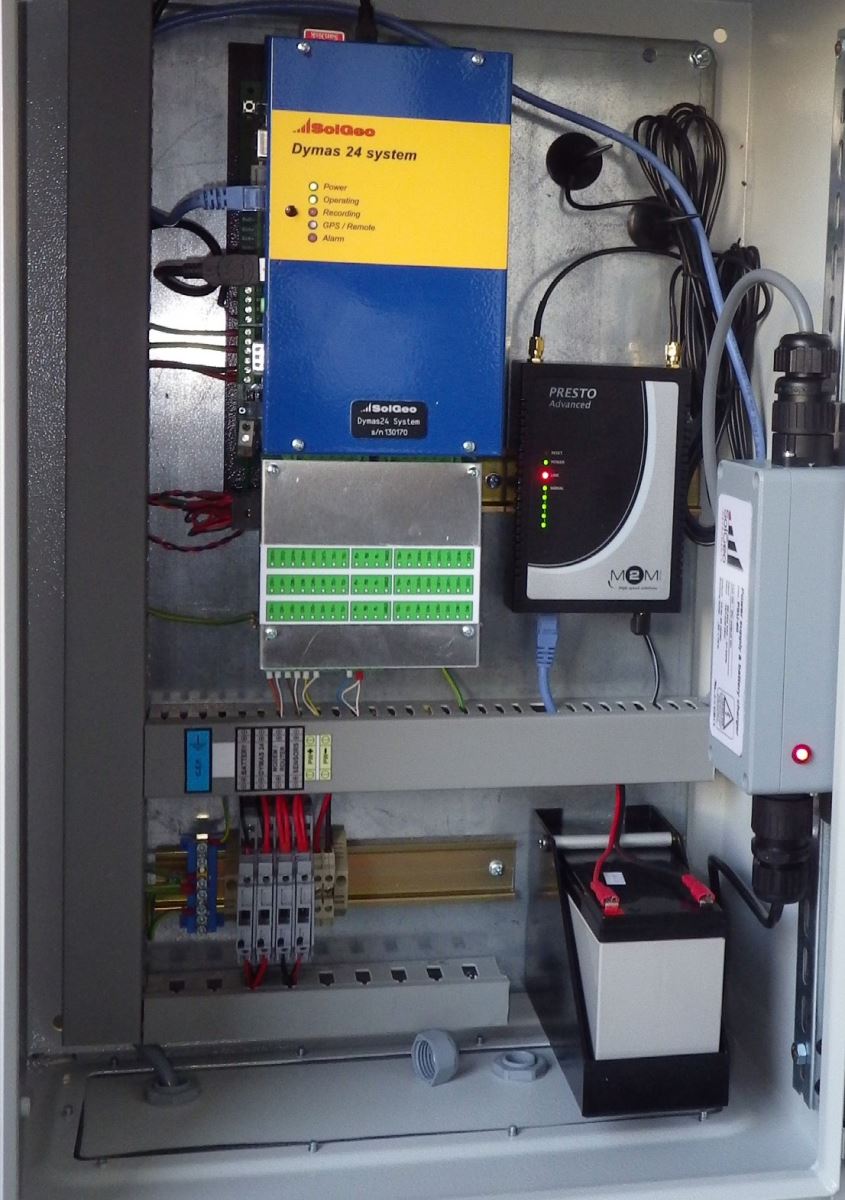
Standard guidelines: UNI 4150-3, DIN 45669-1, UNI 9916.
Multichannel recorder allows to join up to 30 channels in multiples of 6 positioned in a single metallic cabinet provided for wall or floor fixing.
LAN connection communication system. Connection to remote system is provided by 4G/3G/UMTS, GPRS, OPTICAL FIBER MODEM, WiFi and other on request.
The management software DYMASOFT, integrated with VIBRO-SOFT data processing software allows to build up efficient dynamic monitoring networks.
Applications:
- Multi-channel acquisition system for long-term monitoring with stable configuration inside dams and structures.
Technical features:
- Data storage: 2GB internal memory card for 6 channel group (till to 32GB optional);
- Converter: Individual 24-bit Sigma/Delta per each channel, with DSP each 6 channels, integrated digital antialiasing filter;
.jpg) - Sampling: Selectable from 10Hz to 8KHz;
- Sampling: Selectable from 10Hz to 8KHz;
- Bandwidth: DC – 4KHz;
- Dynamic range: >134 dB;
- Power: 10 VDC to 18 VDC (adapter 120/240 VAC optional), automatic turn OFF when battery <10,2 V, turn ON >11,8 V;
- Working temperature: -20°C to +70°C.
2. Portable Seismic recorder MAS24-DY
The high resolution integrated unit (24-bit sampling and >135 dB) up to 12 channels, can operate as a strong motion vibration acquisition unit or micro seismic recorder, according with international standards DIN 45669, DIN 4150-3-1 and UNI 9916 and EN 61000 61326-1.
Internal GPS receiver for synchronization of all acquisition units without any connection.
Software packages for data setting, processing and visualization.
Signal recording in case of event plus minimum and maximum values for all channels.
Ap.jpg) plications:
plications:
- Civil and industrial vibrations monitoring;
- Natural or anthropic seismic monitoring.
Technical features:
- Input channels: From 1 to 6 sensor channel (12 optionally);
- Data storage: 32GB internal SD memory; optional external USB flash disk on request;
- Sampling: 10Hz - 8KHz;
- Bandwidth: DC – 3,200Hz;
- Dynamic range: >135 dB@100Hz;
- Timing: Sampling and internal RTC synchronized via GPS or remote control - all channels simul-taneous sampling;
- Diagnostics: LiFePO4 12,8V 10,8Ah; working time: >16h; charging time: 4h;
- Power consumption: 6W for 6 channel group (active);
- Communication: Ethernet TCP/IP via cable or optionally by GSM or WiFi modem;
- Power: 10 VDC to 15 VDC, automatic switch between internal battery and external power supply;
- Working temperature: -10°C to +50°C.
B. SENSORS
1. Seismometer VELOGET
Triaxial Class I Surface seismometer, extremely compact and housed in IP67 metal case. It is conform to reference standards DIN 4150-3, DIN 45669-1, UNI 9916 and UNI 9614.
Three different configurations, triaxialbiaxial and monoaxial for vertical or horizontal applications. It is equipped with military connector or with cable for fixed installations.
It is made up by three electronically linearized geophones with high dynamic >130 dB and is the perfect in combination with Dymas series. A particular system on bottom allows the fixing on the ground/wall with a single little screws perfectly horizontal.
The internal electronics provides test management.
Applications:

-HVSR measurement ;
-Civil monitoring;
-Seismic networks.
Technical features:
- Case to coil motion: 2,5mm (p-p);
- Frequency range: Selectable, 1-80Hz or 1-315Hz ;
- Dynamic range: >130dB;
- Measure range: +/- 125mm/s or +/-12,5mm/s @16Hz see nomogram measuring range;
- Sensitivity: Selectable 40 V/m/s or 400 V/m/s;
- Spectral noise: 3,5nm/s (rm/s, 16Hz - 200Hz), 55nm/s (rm/s 1Hz - 315Hz);
- Linearity: +/- 0,4dB (class 1 - DIN 45699-1);
- Self-test: Active self-test, impulse 10mm/s;
- Temperature range: -20°C to +60°C.
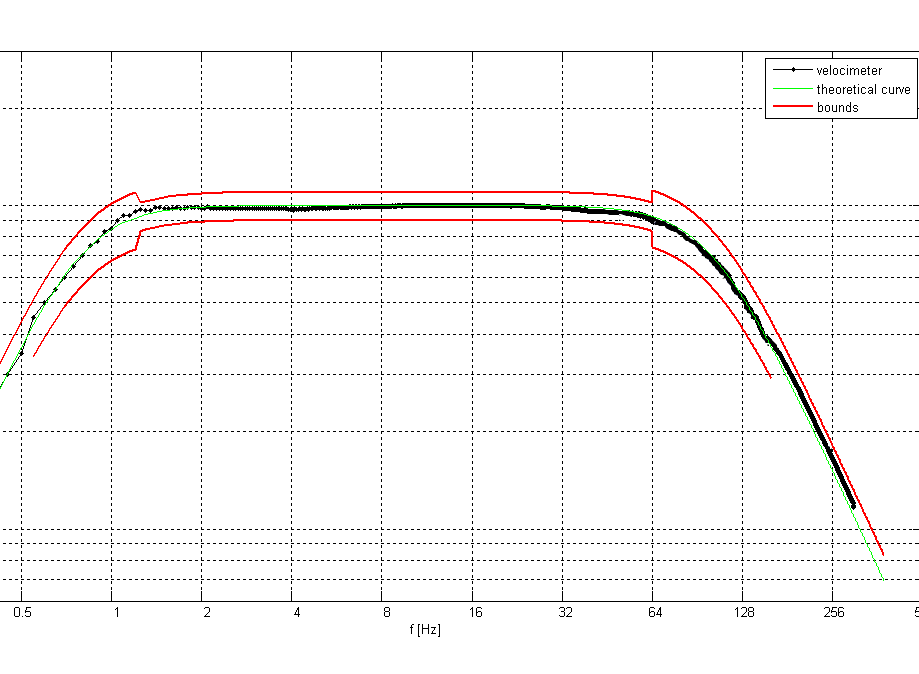
2. Force Balance Accelerometer AFB
Force Balance triaxle Accelerometer, DC-200 Hz strong motion >160 dB.
Accelerometers are high-sensitivity, low noise sensors designed for use in seismic and low level, low frequency motion studies.
The accelerometers are self-contained and provide a high level, low impedance output. No signal conditioning is required in most applications.
These sensors utilize low noise electronics in conjunction with the force balance principle to make possible measurements in the low frequency micro-G range. Aside from the traditional DC-coupled zero output, the AFB-3C & 2C & 1C also provides AC-coupled zero output which eliminates tiltinduced or offset errors facilitating high amplification of the basic output.
Applications:
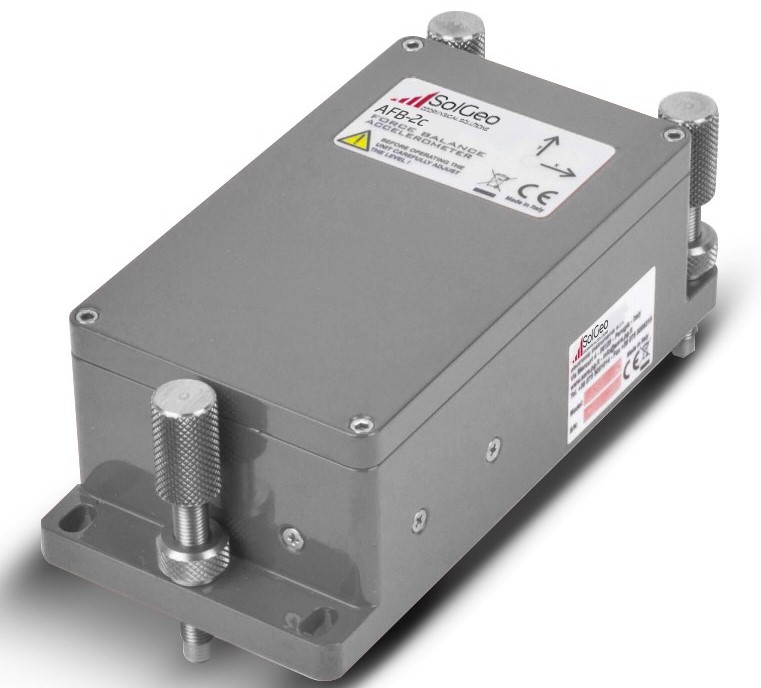
- Long-term monitoring on dams;
- Buildings and heritage structures;
- Monitoring that requires higher sensitivity.
Technical features:
- Ranges available: ±0.25G, ±0.5G, ±1G, ±2G, ±4G;
- Output voltage: ±10 Volts differential;
- Bandwidth: Standard 0-200Hz;
- Input test: 1/8 FS;
- Nominal sensitivity: 2.5 V/g;
- Orthogonality error: < 0.01%;
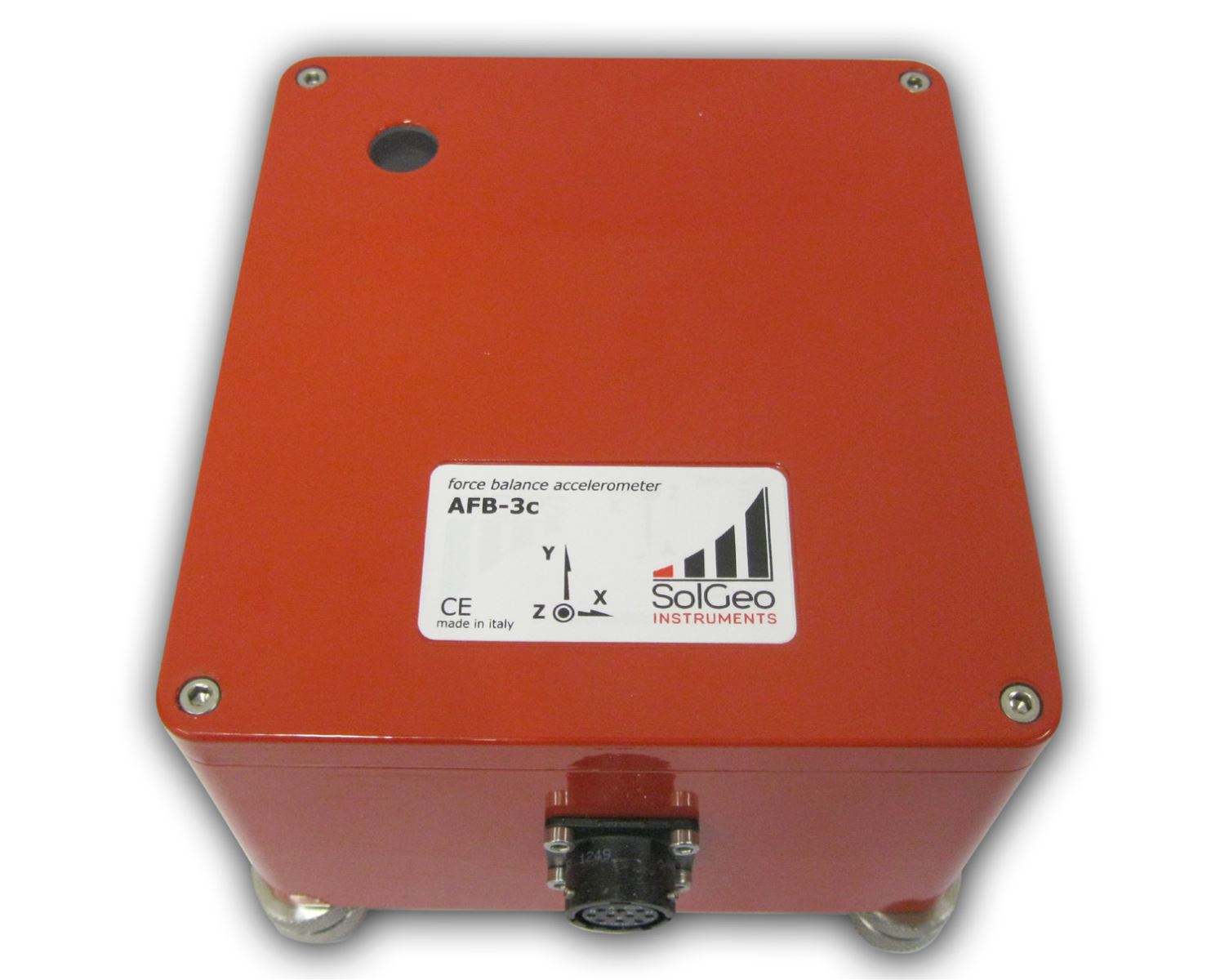 - Dynamic range: >165dB (from 0.1Hz to 20Hz with +/-1g setup);
- Dynamic range: >165dB (from 0.1Hz to 20Hz with +/-1g setup);
- Offset drift: 0.000001 g/°C;
- Damping: 0.707;
- Cross axis sensitivity: <0.3%;
- Non-linearity: <0.1% F.R;
- Supply voltage: 10 - 15 VDC (80mA for 3 axis unit);
- Temperature, operating: -20 to +55°C;
- Temperature, storage: -40 to +90°C;
- Protection: IP66 (IP67, IP68 optinonally).
3. Accelerometer AMS
Models AMS is a high sensitivity sensor, designed for seismic purposes and low level, low frequency motion studies.
The accelerometers provide a high level, low impedance output. No signal conditioning is required in most of applications. These sensors utilize low noise mems dispositive in order to provide low frequency micro-G range measurement.
Main features:
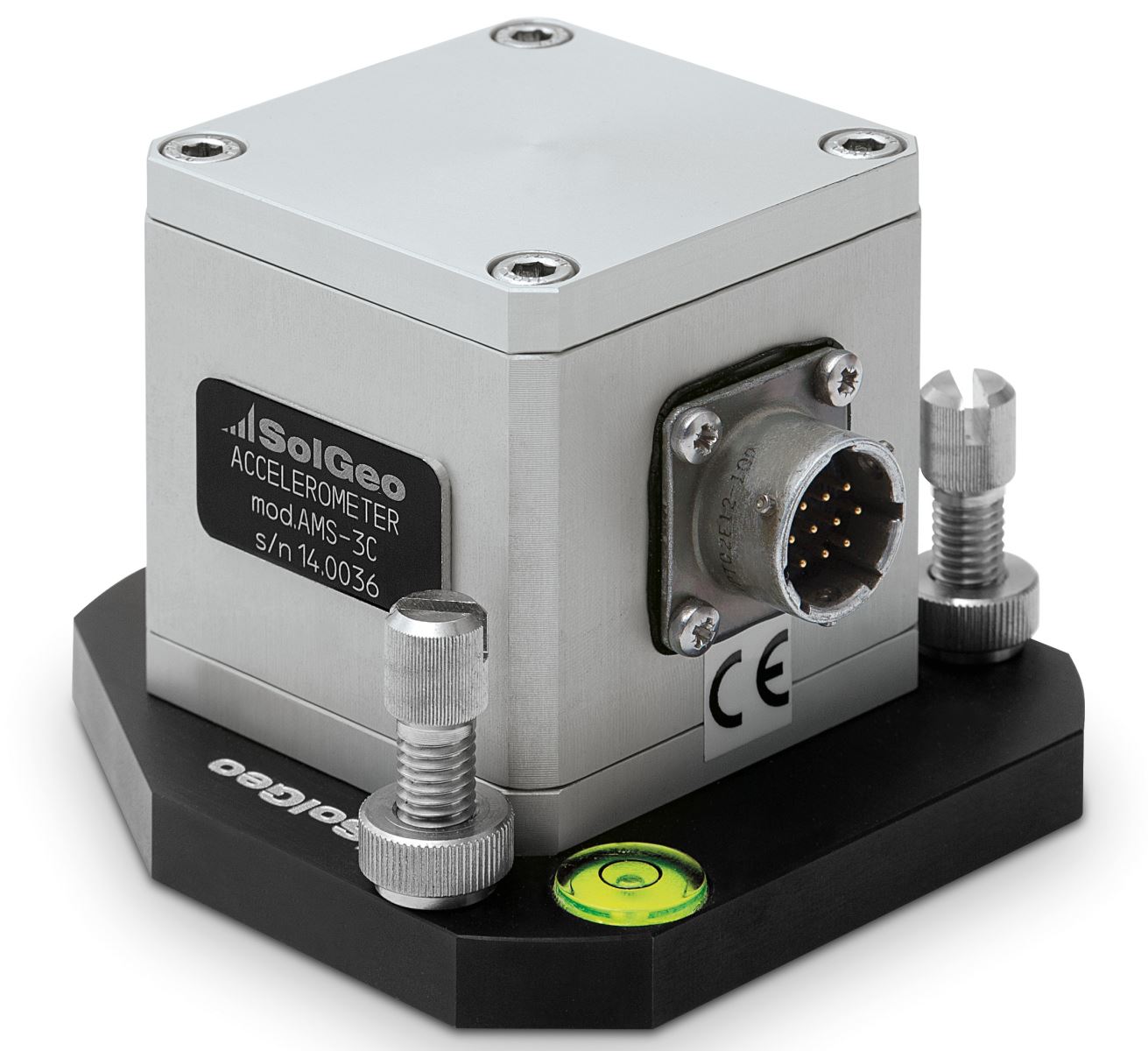
- Single, biaxial or triaxial accelerometer settings within the same case.
- 3 different types of fixing.
- 3 different output cable types: straight-connector or corner-connector with 90° angle or gland cable.
- IP67 100% waterproof case.
Applications:
- Temporary or quick vibration measurements;
- Disturbance to the person;
- Though environmental conditions.
Technical features:
.jpg)
- Full scale acceleration (input range): ± 2G or ± 5G;
- Output voltage: ± 4 Volts;
- Sensitivity: 2000 mv/g – 800mv/g (5g type);
- Frequency response: 0 – 400 Hz (nominal, -3dB);
- Operating voltage: +6 to +18 VDC 8 mA (for single axis);
- Output impedance: 90 Ohms;
- Dynamic range: >100 dB;
- Sensitive axis alignment: Better than 0.25°;
- Scale factor temp coefficient: -250 to 250 Ppm/C° Max (-55 to 125°C);
- Output noise: <70 µV RMS from 0 to 50 Hz;
- Temperature, operating: -40 to +80°C;
- Ambient pressure: 0 to 5 bar;
4. Accelerometer Mems/AMD
Solgeo has developed this triaxial mems accelerometer with performances suitable for monitoring structures such as bridges, viaducts, tunnels in road and rail environment, both for direct measurement of accelerations and displacements but also suitable for modal analysis of structures.
It is characterised by high response accuracy, good dynamics especially at low frequencies (those of interest), high robustness to atmospheric agents and shocks, all at a very competitive price for widespread installation.
It connects directly to the Dymas24 series acquirers that manage the internal test.
Main features:

- Optimised dynamics and linearity.
- Robustness and reliability.
- 3 different types of fixing.
- Internal test.
- Connector or cable gland output.
Technical features:
- Full scale acceleration (input range): ± 2G, ± 4G; ± 8G;
- Output voltage: ± 4 Volts;
- Sensitivity: 2000 mV / g - 1000 mV / g (loại ± 4g); 500 mV / g (loại ± 8g);
- Frequency response: 0 - 400 Hz ;
- Operating voltage: : +5 to +18 VDC 8 mA;
- Output impedance: 90 Ohms;
- Dynamic range::> 80 dB to 100 dB ;
- Scale factor temp coefficient: 100 ppm / C ° Max (-40 to 125 ° C);
- Output noise: <22,5 µg / Hz;
- Temperature, operating: -40 to +80°C;
- Ambient pressure: 0 to 5 bar;